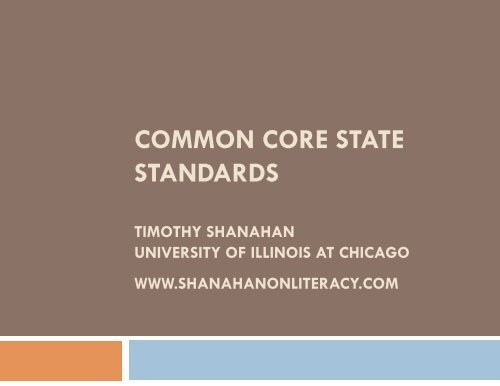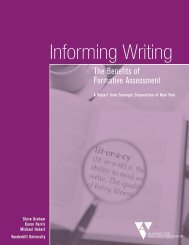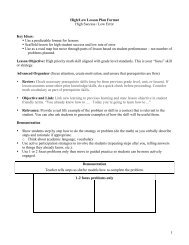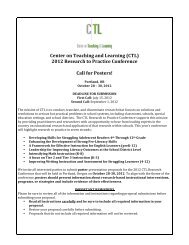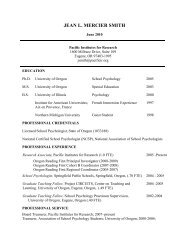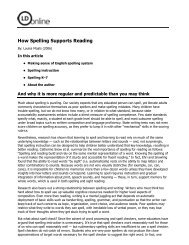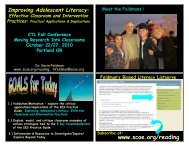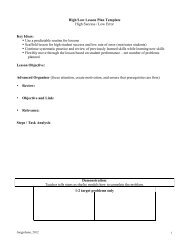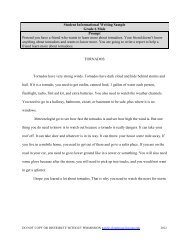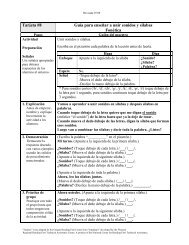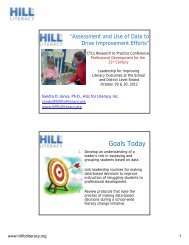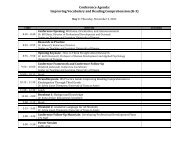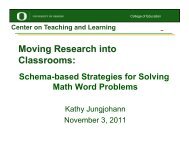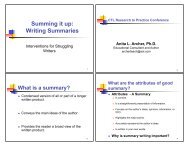4.1 Tim Shanahan - Common Core State Standards - Presentation
4.1 Tim Shanahan - Common Core State Standards - Presentation
4.1 Tim Shanahan - Common Core State Standards - Presentation
Create successful ePaper yourself
Turn your PDF publications into a flip-book with our unique Google optimized e-Paper software.
COMMON CORE STATE<br />
STANDARDS<br />
TIMOTHY SHANAHAN<br />
UNIVERSITY OF ILLINOIS AT CHICAGO<br />
WWW.SHANAHANONLITERACY.COM
<strong>Tim</strong>othy <strong>Shanahan</strong><br />
Professor, Urban Education, University of Illinois at<br />
Chicago<br />
Former director, Chicago Public Schools<br />
Past President, International Reading Association<br />
Member of the National Reading Panel<br />
Chair, National Early Literacy Panel<br />
Chair, National Literacy Panel for<br />
Language Minority Children and Youth<br />
Member, <strong>Common</strong> <strong>Core</strong> <strong>Standards</strong> K-12<br />
Development Team (ELA)
History of <strong>Standards</strong><br />
1989 – National Governors Association gives birth<br />
to the standards movement<br />
1990 – National Education Goals Panel established<br />
1996 – Achieve, Inc. launched<br />
2001 – No Child Left Behind becomes law<br />
2009 – <strong>Common</strong> <strong>Core</strong> <strong>State</strong> <strong>Standards</strong> effort<br />
2010 – <strong>Common</strong> <strong>Core</strong> <strong>State</strong> <strong>Standards</strong>
Source of the <strong>Standards</strong><br />
National Governors Association<br />
Council of Chief <strong>State</strong> School Officers<br />
Gates Foundation Support<br />
U.S. Department of Education (Race to the Top)
Purpose of common standards<br />
To improve U.S. educational attainment by focusing<br />
schools on higher learning goals<br />
To standardize educational opportunity<br />
To focus attention on fewer, higher, better standards<br />
(more on outcomes than on processes)
Status update<br />
Draft standards issued in February, 2010<br />
37 states have signed on<br />
Final revisions pending<br />
<strong>State</strong> adjustments (15%)<br />
Testing plan (Reach to the Top Assessment)
Curriculum Coverage & Structure<br />
English Language Arts<br />
Mathematics<br />
No other areas of the curriculum slated for inclusion<br />
at this time<br />
Small number of college and career readiness<br />
standards organized within themes/categories<br />
Backmapping (K-12) to show how attainment can be<br />
accomplished
What makes these standards special<br />
Independent analysis indicates that they are more<br />
rigorous/demanding than the standards of 37 states<br />
That they are held in common by so many states should<br />
mean less tailoring of textbooks and assessments<br />
Internationally benchmarked<br />
They go through grade 12 (ACT report)<br />
Increased stress on expository text, critical reading,<br />
and use of technology<br />
Emphasis on disciplinary literacy in the upper grades<br />
Recognition of importance of text difficulty<br />
Recognition of value of canonical text
English Language Arts<br />
Reading<br />
Writing<br />
Speaking and Listening<br />
Language (conventions and vocabulary)<br />
Reading (foundational skills – K-3)
Reading Themes/Categories<br />
A. Key ideas and details<br />
B. Craft and structure<br />
C. Integration of knowledge and ideas<br />
D. Range and level of text complexity
Key Ideas and Details<br />
What did the author say<br />
Students should be able to determine what texts<br />
say explicitly and be able to summarize them<br />
(including central ideas/themes, how ideas and<br />
characters develop and interact), making logical<br />
inferences, and citing textual evidence to support<br />
conclusions.
Craft and Structure<br />
How did the author say it<br />
Students should be able to interpret the meanings<br />
of words and phrases and the structure of texts to<br />
determine how they affect meaning or tone, and<br />
how points of view and purpose shape content and<br />
style.
Integration of Knowledge and Ideas<br />
How do I evaluate what the author has told me and<br />
how can I go beyond what the author has told me<br />
Students should be able to synthesize and compare<br />
information from print and digital sources, and<br />
critically evaluate the reasoning and rhetoric of a<br />
text.
Range and Level of Text Complexity<br />
How challenging and varied is the text<br />
Students should be able to read complex texts<br />
proficiently for a variety of purposes.
Writing: Themes/Categories<br />
Text types and purposes<br />
Production and distribution of writing<br />
Research to build knowledge<br />
Range of writing
Text Types and Purposes<br />
Students should be able to write effective arguments,<br />
informative/explanatory texts, and narratives.
Production and Distribution of Writing<br />
Students should be able to make their texts<br />
appropriate to varying task demands, purposes and<br />
audiences (using writing processes and technology).
Research to Build Knowledge<br />
Students should learn to conduct research, gathering<br />
relevant information from multiple sources (judging<br />
their credibility and accuracy), and using the<br />
information in their writing.
Range of Writing<br />
Students should be able to produce quality writing<br />
under a range of circumstances and demands.
Speaking and Listening Themes/Categories<br />
Comprehension and collaboration<br />
<strong>Presentation</strong> of knowledge and ideas
Comprehension and Collaboration<br />
Students should learn to participate effectively in oral<br />
interactions, integrating and evaluating information,<br />
and evaluating the speaker’s message, perspective,<br />
and rhetoric.
<strong>Presentation</strong> of Knowledge and Ideas<br />
Students should learn to present information in clear<br />
and appropriate ways, to use digital media and other<br />
displays to support such presentations, and to adapt<br />
speech to the demands of a variety of contexts and<br />
tasks.
Language Themes/Categories<br />
Conventions of writing and speaking<br />
Vocabulary acquisition and use
Conventions of Writing and Speaking<br />
Students should learn to use appropriate grammar<br />
and usage, capitalization, spelling, and punctuation,<br />
and to make effective word and sentence structure<br />
choices to convey meaning effectively.
Vocabulary Acquisition and Use<br />
Students should determine the meaning of words and<br />
phrases, understand the nuances of words and the<br />
relationships among words, using grade level<br />
academic vocabulary.
Foundational Reading Skills (K-3)<br />
Phonics and word recognition<br />
Fluency
Phonics and Word Recognition<br />
Students should learn to apply grade level phonics<br />
and word analysis skills.
Fluency<br />
Students should learn to read with sufficient accuracy<br />
and fluency to support comprehension.
Backmapping: Reading Key Ideas<br />
With prompting and support, ask and answer questions<br />
about details/information and events in literature and<br />
informational text (K)<br />
Ask and answer questions about key details/<br />
information and events in literature and informational<br />
text (1)<br />
Ask and answer such questions as who, what, where,<br />
when, why, and how to demonstrate understanding of<br />
key details/ information and events in literature and<br />
informational text (2)<br />
Ask and answer questions to demonstrate<br />
understanding, explicitly using the text (literary and<br />
informational) as the basis for answers (3)
Backmapping: Reading Key Ideas<br />
(cont.)<br />
<br />
<br />
<br />
<br />
<br />
<br />
Draw on details and examples from a text to support statements<br />
about the literary and informational texts (4)<br />
Quote from literary and informational texts to support statements<br />
about the text (5)<br />
Cite specific textual evidence to support analysis of what the<br />
literary and informational texts say explicitly as well as inferences<br />
drawn from the texts (6)<br />
Cite several sources of textual evidence when useful to support<br />
analysis of what literary and informational texts say explicitly as<br />
well as inferences drawn from the text (7-8)<br />
Cite specific textual evidence (in social studies/history) to support<br />
analysis of primary and secondary sources (6-8)<br />
Cite specific textual evidence to support analysis of scientific and<br />
technical texts (6-8)
Backmapping: Reading Key Ideas<br />
(cont.)<br />
<br />
<br />
<br />
<br />
<br />
<br />
Cite evidence in literary/informational texts that most strongly supports a specific<br />
analysis of what the text say explicitly as well as inferences drawn from the text<br />
(9-10)<br />
Cite specific textual evidence (in history/social studies) to support analysis of<br />
primary and secondary sources, attending to such features as the date and origin<br />
of the information (9-10)<br />
Cite specific textual evidence to support analysis of scientific and technical text,<br />
including analysis of the precise details of explanations or descriptions (9-10)<br />
Cite strong and thorough textual evidence (literary, informational) to support<br />
analysis of what the text says explicitly as well as inferences drawn from the text,<br />
including determining where the text leaves things uncertain (11-12)<br />
Cite specific textual evidence (in history/social studies) to support analysis of<br />
primary and secondary sources, connecting insights gained from specific details to<br />
an understanding of the text as a whole (11-12)<br />
Cite specific textual evidence to support analysis of scientific and technical texts,<br />
including analysis of important distinctions the author makes between ideas or<br />
pieces of information (11-12)
What do you notice about<br />
the progression<br />
The skills get more specific and demanding<br />
Recognition of details as a support to broader<br />
interpretation of text<br />
Text difficulty (including ambiguity) is a critical criterion<br />
in determining the progression<br />
There is an emphasis on informational text from the<br />
earliest grades<br />
The special consideration of science and history/social<br />
studies<br />
The strong stress on using information as evidence
Backmapping: Integration of<br />
Knowledge and Ideas<br />
<br />
<br />
<br />
<br />
Compare and contrast the adventures of characters in familiar<br />
stories and (with prompting and support) recognize basic<br />
similarities in and differences between two texts on the same topic<br />
(K)<br />
Compare and contrast two or more versions of the same story by<br />
different authors or from different cultures and identify similarities<br />
in and differences between two texts on the same topic (1)<br />
Compare and contrast characters or events from different stories<br />
addressing similar themes and describe similarities in and<br />
differences between two texts on the same topic (2)<br />
Compare and contrast the plots, setting, and themes of stories<br />
written by the same author about the same or similar characters<br />
and differences between two texts on the same topic (3)
Backmapping: Integration of<br />
Knowledge and Ideas (cont.)<br />
<br />
<br />
<br />
<br />
Compare and contrast thematically similar tales, myths, and<br />
accounts of events from various cultures and describe how two or<br />
more texts on the same subject build on one another, providing a<br />
coherent picture of the information they convey (4)<br />
Compare the treatment of similar ideas and themes (e.g.,<br />
opposition of good and evil) as well as character types and<br />
patterns of events in myths and traditional literature from different<br />
cultures and integrate information from several texts on the same<br />
subject in order to write or speak about the subject<br />
knowledgeably (5)<br />
Analyze stories in the same genre, comparing and contrasting their<br />
approaches to similar themes and topics (6)<br />
Analyze a specific case in which a modern work of fiction draws<br />
on patterns of events or character types found in traditional<br />
literature (7)
Backmapping: Integration of<br />
Knowledge and Ideas (cont.)<br />
Compare a fictional portrayal of a time, place, or character<br />
to historical sources from the same period as a means of<br />
understanding how authors use or alter history (8)<br />
Analyze the relationship between a primary and secondary<br />
source on the same topic in history/social studies (6-8)<br />
Compare and contrast the information gained from<br />
experiments, simulations, video, or multimedia sources with<br />
that gained from reading a science text on the same topic<br />
(6-8)<br />
Analyze a wide range of 19 th and early 20 th century<br />
foundational works of American literature, comparing and<br />
contrasting approaches to similar ideas or themes in two or<br />
more texts from the same period (9-10)
Backmapping: Integration of<br />
Knowledge and Ideas (cont.)<br />
<br />
<br />
<br />
<br />
<br />
Compare and contrast treatments of the same topic in several<br />
primary and secondary sources in history/social studies (9-10)<br />
Compare experimental findings presented in a text to information<br />
from other sources, noting when the findings support or contradict<br />
previous explanations or accounts in science (9-10)<br />
Analyze how an author draws on and transforms fictional source<br />
material in a specific work (e.g., how Shakespeare draws on a<br />
story from Ovid or how a later author draws on a play by<br />
Shakespeare) (11-12)<br />
Integrate information from diverse sources, both primary and<br />
secondary, into a coherent understanding of an idea or event,<br />
noting discrepancies among sources in history/social studies<br />
(11-12)<br />
Integrate information from diverse sources into a coherent<br />
understanding of a scientific concept, process, or phenomenon,<br />
noting discrepancies among sources (11-12)
What do you notice about<br />
the progression<br />
The emphasis on multiple texts from earliest grade<br />
levels<br />
The inclusion of other kinds of information,<br />
particularly in science<br />
Emphasis on canonical literary works<br />
Requirements for analysis, synthesis, and<br />
comparative evaluation
Text Complexity<br />
The independence of skills and text complexity<br />
Three-part model for measurement<br />
1. Qualitative dimensions<br />
2. Quantitative dimensions<br />
3. Reader and task considerations
Qualitative Dimensions<br />
<br />
<br />
<br />
<br />
<br />
Those aspects of text difficulty best measured by an attentive<br />
reader:<br />
Levels of meaning: texts with single clear, explicit meanings are<br />
easier than texts with multiple, implicit, hidden, or obscure<br />
meanings<br />
Structure: low structural complexity (simple, well-marked,<br />
conventional structures) vs. high complexity (complex, subtle,<br />
unconventional structures); role of graphics<br />
Language conventionality/clarity (literal, clear, everyday<br />
language vs. figurative, ironic, ambiguous, purposely misleading,<br />
archaic, or unfamiliar language)<br />
Knowledge demands: texts that make few assumptions about<br />
readers’ life experiences versus texts that make many such<br />
assumptions
Quantitative Dimensions<br />
Word frequency<br />
Sentence length<br />
Text cohesion<br />
Lexile Framework<br />
Coh-Metrix (text cohesion, abstractness of words,<br />
etc.)
Text Selection<br />
Lexiles<br />
But adjusted by the factors measured by Coh-<br />
Metrix and teacher judgments based on knowledge<br />
of students<br />
Exemplars are provided
History and Science Reading<br />
Not just reading standards imposed on history and<br />
science, but disciplinary considerations were central<br />
Consideration of author in history text (comparing<br />
author’s points of view, or how an author makes<br />
claims, or refines vocabulary meaning, etc.)<br />
While in science it is more about analysis of<br />
investigations and determining what is known and<br />
not known<br />
Need to consider graphical<br />
information, not just prose
Multiple Texts<br />
<br />
<br />
<br />
<br />
<br />
<br />
<br />
Compare and contrast the adventures of characters in familiar stories<br />
(K)<br />
With prompting and support, recognize basis similarities in and<br />
differences between two texts on the same topic (e.g., in illustrations<br />
or descriptions) (K)<br />
Distinguish major categories of writing from each other (e.g., stories<br />
and poems), drawing on a wide reading of a range of text types (1)<br />
Compare and contrast two or more versions of the same story (e.g.,<br />
Cinderella stories) by different authors or from different cultures (1)<br />
Identify similarities in and differences between two texts on the same<br />
topic (e.g., in illustrations or descriptions) (1)<br />
Compare and contrast characters or events from different stories<br />
addressing similar themes (2)<br />
Describe similarities in and differences between two texts on the<br />
same topic (2)
Multiple Texts<br />
<br />
<br />
<br />
<br />
<br />
<br />
Compare and contrast the plots, settings, and themes of stories<br />
written by the same author about the same or similar characters (e.g.,<br />
in books in a series) (3)<br />
Compare and contrast information drawn from two texts on the same<br />
subject (3)<br />
Compare and contrast thematically similar tales, myths, and accounts<br />
of events from various cultures (4)<br />
Describe how two or more texts on the same subject build on one<br />
another; provide a coherent picture of the same information they<br />
convey (4)<br />
Compare the treatment of similar ideas and themes (e.g., opposition<br />
of a good and evil) as well as character types and patterns of<br />
events in myths and other traditional literature from different cultures<br />
(5)<br />
Integrate information from several texts on the same subject in order<br />
to write or speak about the subject knowledgeably (5)
Multiple Texts<br />
<br />
<br />
<br />
<br />
<br />
<br />
<br />
<br />
Analyze stories in the same genre (e.g., mysteries, adventure stories), comparing and<br />
contrasting their approaches to similar themes and topics (6)<br />
Assess the similarities and differences between two or more texts on the same subject and<br />
apply the knowledge gained to inform reading of additional texts (6)<br />
Analyze a specific case in which a modern work of fiction drawn on patterns of events or<br />
character types found in traditional literature (7)<br />
Analyze where two or more texts provide conflicting information on the same subject and<br />
determine whether the texts disagree on matters of fact or on matters of interpretation (7)<br />
Compare a fictional portrayal of a time, place, or character to historical sources from the<br />
same period as a means of understanding how authors use or alter history (8)<br />
Compare and contrast how two or more authors writing about the same topic shape their<br />
presentations of key information by emphasizing different evidence or advancing different<br />
interpretations of facts (8)<br />
Analyze the relationship between a primary and secondary source on the same topic<br />
(History, 6-8)<br />
Compare and contrast the information gained from experiments, simulations, video, or<br />
multimedia sources with that gained from reading a text on the same topic (Science, 6-8)
Multiple Texts<br />
<br />
<br />
<br />
<br />
<br />
<br />
Analyze a wide range of 19 th and early 20 th century foundational works of<br />
American literature, comparing and contrasting approaches to similar idea or<br />
themes in two or more texts from the same period (9-10)<br />
Analyze how authors argue with or otherwise respond to one another’s ideas or<br />
accounts of key events, evaluating the strength of each author’s interpretation<br />
(9-10)<br />
Compare and contrast treatments of the same topic in several primary and<br />
secondary sources (9-10, History)<br />
Compare experimental findings presented in a text to information from other<br />
sources, noting when the findings support or contradict previous explanations or<br />
accounts (9-10, Science)<br />
Analyze how an author draws on and transforms fictional source material in a<br />
specific work (e.g., how Shakespeare draws on a story from Ovid or how a<br />
later author draws on a play by Shakespeare) (11-12)<br />
Synthesize explanations and arguments from diverse sources to provide a<br />
coherent account of events or ideas, including resolving conflicting information<br />
(11-12)
Multiple Texts<br />
<br />
<br />
Integrate information from diverse sources, both primary and secondary,<br />
into a coherent understanding of an idea or event, noting discrepancies<br />
among sources (11-12)<br />
Integrate information from diverse sources (e.g., video, multimedia sources,<br />
experiments, simulations) into a coherent understanding of a concept,<br />
process, or phenomenon, noting discrepancies among sources (11-12)
For more information<br />
http://www.corestandards.org/
COMMON CORE STATE<br />
STANDARDS<br />
TIMOTHY SHANAHAN<br />
UNIVERSITY OF ILLINOIS AT CHICAGO<br />
WWW.SHANAHANONLITERACY.COM


